

Directed by: Peter Lord & Nick Park
Written by: Karey Kirkpatrick & Jack
Rosenthal
Music by: Harry Gregson-Williams &
John Powell
Production Start Date: September 15, 1997
Released on: June 23, 2000
Running Time: 84 minutes
Budget: $42 million
U.S. Opening Weekend: $17.506 million
over 2,491
Box-Office: $106.8 million in the U.S.,
$175 million worldwide
Rocky the Rooster... Mel Gibson
Ginger... Julia Sawalha (Safron Monsoon in Absolutely Fabulous)
Babs... Jane Horrocks
Bunty... Imelda Staunton
Fowler... Benjamin Whitrow
Mrs. Tweedy... Miranda Richardson
Mr. Tweedy... Tony Haygarth
A comedy drama set on a Yorkshire chicken farm in 1950s England, the story follows the turbulent romance between Rocky the Rooster and Ginger the chicken, both of whom yearn for freedom and are plan a daring "prisoner of war" style escape. Both chickens are tired of being repressed and know they face an eventual certain death, so in planning their escape, they rally with their fellow chickens.
![]() This film
is based on an original story written by Peter Lord and Nick Park in 1995;
Jack Rosenthal started working on the screenplay since 1996.
This film
is based on an original story written by Peter Lord and Nick Park in 1995;
Jack Rosenthal started working on the screenplay since 1996.

![]() Chicken
Run was THE animated film of 2000 -following a string of critical disappointments
(The Road to El Dorado, Dinosaur,
Titan
A.E.,
The Emperor's New
Groove). Critics showered the movie at its opening, with more praise
than they ordinarily reserve for even the most successful Disney films.
"It's immensely satisfying, a divinely relaxed and confident film," writes
Elvis Mitchell in the New York Times. Mitchell observes that the
folks at DreamWorks were apparently responsible for toning the content
down from the subversive spirit that animator Nick Park is noted for. He
adds, that the film "doesn't try to cram messages of uplift down its audience's
gullet. It's a great eggscape from banality." But Kenneth Turan in the
Los
Angeles Times gives credit directly to Park for its artistic achievement.
"This is a joke told by a person, not a corporation," he writes, "and that
makes all the difference." Jonathan Foreman in the
New York Post
calls the film a "triumph of claymation," adding that it is "not only an
amazing technical accomplishment, it's also the wittiest and best-voiced
animated movie to come along in years." Susan Wloszczyna in USA Today
notes that the film contains some can't-miss ingredients: "A little slapstick,
a little action, rich characters and a whopping serving of wit. All baked
to near-perfection."
Chicken
Run was THE animated film of 2000 -following a string of critical disappointments
(The Road to El Dorado, Dinosaur,
Titan
A.E.,
The Emperor's New
Groove). Critics showered the movie at its opening, with more praise
than they ordinarily reserve for even the most successful Disney films.
"It's immensely satisfying, a divinely relaxed and confident film," writes
Elvis Mitchell in the New York Times. Mitchell observes that the
folks at DreamWorks were apparently responsible for toning the content
down from the subversive spirit that animator Nick Park is noted for. He
adds, that the film "doesn't try to cram messages of uplift down its audience's
gullet. It's a great eggscape from banality." But Kenneth Turan in the
Los
Angeles Times gives credit directly to Park for its artistic achievement.
"This is a joke told by a person, not a corporation," he writes, "and that
makes all the difference." Jonathan Foreman in the
New York Post
calls the film a "triumph of claymation," adding that it is "not only an
amazing technical accomplishment, it's also the wittiest and best-voiced
animated movie to come along in years." Susan Wloszczyna in USA Today
notes that the film contains some can't-miss ingredients: "A little slapstick,
a little action, rich characters and a whopping serving of wit. All baked
to near-perfection."
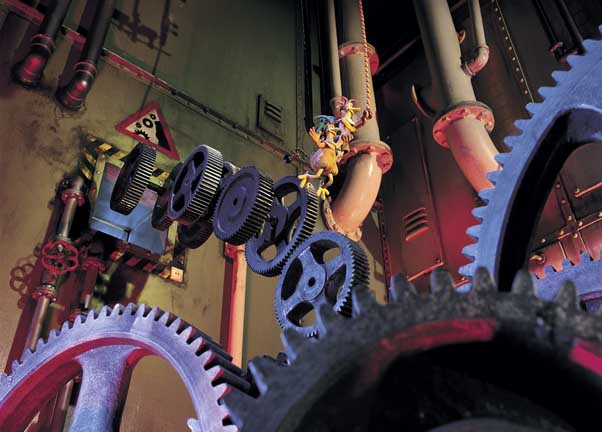
![]() In July 2000, Arthur Sheriff, a spokesman for Bristol-based Aardman Animation
said there is little possibility of a sequel. "We are not going to consider
a Chicken Run II. The studio's next movie will be an Aardman
version of the Aesop Fable The
Tortoise and the Hare - a Tortoise and the Hare meets Spinal
Tap..." Sheriff said Aardman also plans a feature version of the Wallace
& Gromit shorts about a man whose oddball inventions cause
trouble for him and his dog. "Those productions will occupy us for at least
the next five years," he said. "There is of course pressure for a Chicken
Run sequel but right now it would be impossible."
In July 2000, Arthur Sheriff, a spokesman for Bristol-based Aardman Animation
said there is little possibility of a sequel. "We are not going to consider
a Chicken Run II. The studio's next movie will be an Aardman
version of the Aesop Fable The
Tortoise and the Hare - a Tortoise and the Hare meets Spinal
Tap..." Sheriff said Aardman also plans a feature version of the Wallace
& Gromit shorts about a man whose oddball inventions cause
trouble for him and his dog. "Those productions will occupy us for at least
the next five years," he said. "There is of course pressure for a Chicken
Run sequel but right now it would be impossible."
![]() Near the
very end of the credits the conversation about which comes first, the "chicken
or the egg?" comes up again. The two rodents want to take an egg
or a chicken and make a chicken farm to make their own eggs. However,
they cannot deside if they need a chicken or an egg. Finally, Rocky the
Rooster pipes in and says to "please pipe down".
Near the
very end of the credits the conversation about which comes first, the "chicken
or the egg?" comes up again. The two rodents want to take an egg
or a chicken and make a chicken farm to make their own eggs. However,
they cannot deside if they need a chicken or an egg. Finally, Rocky the
Rooster pipes in and says to "please pipe down".
![]() DreamWorks
spent a whopping $45 million marketing Chicken Run -more than its
production cost of $42 million!
DreamWorks
spent a whopping $45 million marketing Chicken Run -more than its
production cost of $42 million!
Directors Peter Lord and Nick Park are mostly famous for producing the Oscar-winning Wallace and Gromit series as well as the classic music video for Peter Gabriel's "Sledgehammer". Dressed simply in T-shirts and jeans, they couldn't be more different: the latter, the old sage of the company, has longish grey hair and a beard, is very gregarious and open, while Park, the man who truly invented Wallace and Gromit, is boyish and introverted. "I guess that means we complement each other”, says Lord. Together, Lord and Park are taking animation to new levels, and their passion and artistry ultimately captured the inevitable attention of Hollywood.
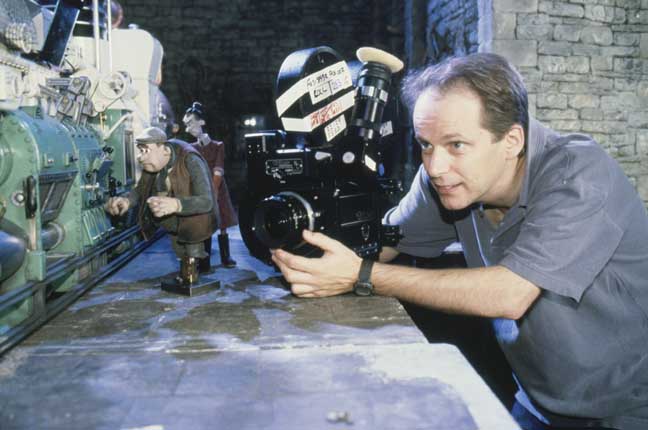 With
DreamWorks' investment, Aardman Studios built a new studio on the outskirts
of Bristol, specifically to house the Chicken Run production, a
mammoth undertaking. "We didn't have space at our smaller studios to do
something of this size and to find a space where we could be self-sufficient,"
explains Lord. The result is a disused factory, now transformed as the
new heart and soul of Aardman, the studio initially founded in 1972 by
David Sproxton and Lord. Times have changed. This is a massive studio,
one with countless corridors and rooms, full of animators designing intricate
body parts, or preparing to shoot complex scenes. It is a far cry from
the commercials that were once the bread and butter of Aardman. In this
studio alone, Chicken Run directors Lord and Park have close to
200 people working for them, on a project that has been 3 years in the
making.
With
DreamWorks' investment, Aardman Studios built a new studio on the outskirts
of Bristol, specifically to house the Chicken Run production, a
mammoth undertaking. "We didn't have space at our smaller studios to do
something of this size and to find a space where we could be self-sufficient,"
explains Lord. The result is a disused factory, now transformed as the
new heart and soul of Aardman, the studio initially founded in 1972 by
David Sproxton and Lord. Times have changed. This is a massive studio,
one with countless corridors and rooms, full of animators designing intricate
body parts, or preparing to shoot complex scenes. It is a far cry from
the commercials that were once the bread and butter of Aardman. In this
studio alone, Chicken Run directors Lord and Park have close to
200 people working for them, on a project that has been 3 years in the
making.
The opening scene is a spoof of the Steve McQueen classic, The Great Escape. Peter Lord spent part of his childhood growing up in Sydney, where he first saw The Great Escape. Now he's taken elements of that film and incorporated them into this animated farce about chickens. Lord says that he's not concerned that those references may find themselves above many a child's head. "I don't think that matters. A lot of inspiration like that comes from your favourite movies or instances in your life and you tend to draw on those. And the sorts of movies that you use tend to be feel-good movies such as Great Escape, as well as Star Wars and Indiana Jones, which you'll also see in the film. We could refer to Bergman -but we don't" Lord adds laughingly.
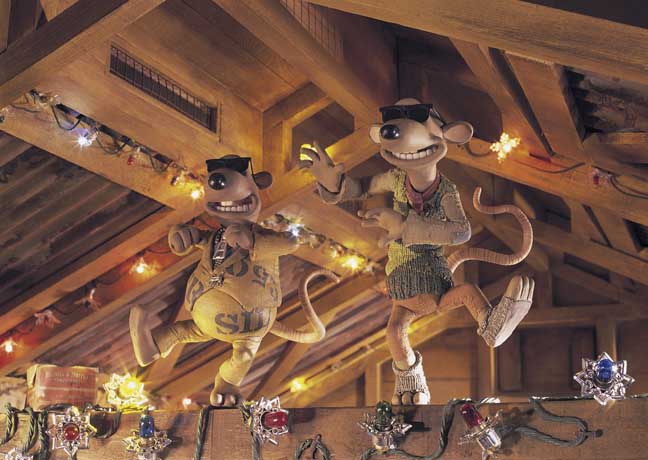 The
initial idea for Chicken Run had an unexpectedly simple genesis, recalls
Park. "It was a single idea that struck us. It came from a sketch that
was in my sketchbook, of a chicken digging its way out of a chicken coop
with a spoon. It just struck us that it resembled a scene from a POW escape
movie with chickens. It seemed like the perfect theme for us to play with,
and we could pick up on the whole escape movie genre. We just thought it
would be fun to make an escape movie with chickens." By the time they had
come up with the idea, Hollywood had already come a calling, and the lucky
studio that ensnared these two Brits, was fledgling studio DreamWorks.
"In Hollywood, you have to have a pitch, so all we told them, was 'it's
an escape movie with chicken'. That's great, because it communicates so
well, and for us, we were able to see ahead to all the comic potential
of that situation, given that chickens are so absurd and ridiculous."
The
initial idea for Chicken Run had an unexpectedly simple genesis, recalls
Park. "It was a single idea that struck us. It came from a sketch that
was in my sketchbook, of a chicken digging its way out of a chicken coop
with a spoon. It just struck us that it resembled a scene from a POW escape
movie with chickens. It seemed like the perfect theme for us to play with,
and we could pick up on the whole escape movie genre. We just thought it
would be fun to make an escape movie with chickens." By the time they had
come up with the idea, Hollywood had already come a calling, and the lucky
studio that ensnared these two Brits, was fledgling studio DreamWorks.
"In Hollywood, you have to have a pitch, so all we told them, was 'it's
an escape movie with chicken'. That's great, because it communicates so
well, and for us, we were able to see ahead to all the comic potential
of that situation, given that chickens are so absurd and ridiculous."
These two unconventional Brits pitched a claymation cartoon about escaping chickens to the two major heads of DreamWorks: Katzenberg and Spielberg. How fortunate that the latter has his own chicken farm. "We hit it off really well", recalls a smiling Park. "Our first meeting with Spielberg was in a restaurant eating chicken, talking about chickens." But without Hollywood, their first foray into feature filmmaking may well have been an unfulfilled dream, adds Lord. “I think it would have been very difficult to raise the funding outside Hollywood. I don’t know because I don’t do the deals, but my impression is when you’re trying to fund the thing with European money, it’s difficult, because no individual has the financial clout of a Hollywood studio.” Before DreamWorks came to the party, Lord concedes that “There was no way we thought we’d do it. It seemed so tactically impossible”.
 The
L.A. restaurant was miles from what this charming duo were used to. Ever
since winning their plethora of Oscars, Hollywood was keen to seduce Peter
and Nick, who never thought it possible to branch out into the more expensive
arena of feature animation. "There was no way we thought we'd do it", says
Lord. "It seemed so tactically impossible, apart from the fear of being
overwhelmed by a Hollywood studio which was very strong." At the same time
"it seemed practically impossible to make anything that big." While studios
such as Disney concentrate on computers, Chicken Run features clay
models, all designed by hand. "Given the fact that the animation world
is moving towards computers and a high tech approach to filmmaking, I feel
as if we're taking on Hollywood with spears and wooden arrows."
The
L.A. restaurant was miles from what this charming duo were used to. Ever
since winning their plethora of Oscars, Hollywood was keen to seduce Peter
and Nick, who never thought it possible to branch out into the more expensive
arena of feature animation. "There was no way we thought we'd do it", says
Lord. "It seemed so tactically impossible, apart from the fear of being
overwhelmed by a Hollywood studio which was very strong." At the same time
"it seemed practically impossible to make anything that big." While studios
such as Disney concentrate on computers, Chicken Run features clay
models, all designed by hand. "Given the fact that the animation world
is moving towards computers and a high tech approach to filmmaking, I feel
as if we're taking on Hollywood with spears and wooden arrows."
Looking around at this studio, though, the spears and arrows are somewhat gargantuan, yet despite its size, one has the feeling that these animators have adopted a more back-to-basics approach to movie animation, concentrating on character and story, rather than digital effects. "I think that's why our films appeal to a broader group than just children," adds Lord.
The British duo from England’s North worked on a film whose screenplay seemed very British in terms of humour and language, yet Lord insists that at no time was there any pressure to make the film more accessible for an American audience, says Park. “Very surprisingly there was no interference on that level at all. We thought that putting a lot of obscure English accents in there might cause a problem, but as long as the JIST of what they were saying came across, that was fine. DreamWorks seemed to respect so much what we do; they were incredibly supportive.”
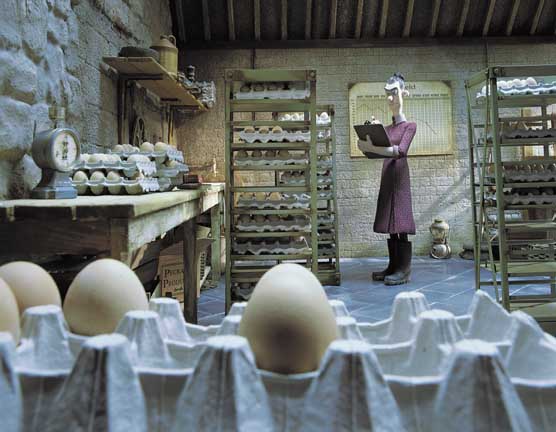 Casting
Chicken
Run presented some interesting challenges, but fortune struck when
Aussie superstar Mel Gibson stepped up to the plate to play the irascible
Rocky the Rooster. It helps that he'd been a great fan of Wallace and Gromit.
"He invited us to lunch one year following the Oscars, for no reason,"
Park explains. As we were developing Rocky, we thought this character was
so similar, and so we animated a line from Maverick to Rocky's puppet and
it fitted really well." Gibson jumped at the chance to do this. "These
guys are so hilarious, and what a funny script", Gibson commented. But
the lead character is in fact the hapless Ginger, beautifully voiced by
the hilarious Julia Sawalha, best known to audiences for her work as Saffy
on the cult hit Absolutely Fabulous. "Ginger is wonderful to play,
a lot of fun," the actress said. This highly animated actress is new to
this strange cartoon (whereby the voices are recorded well before shooting
takes place), so doing this took some getting used to. "I thought I was
going too much
Casting
Chicken
Run presented some interesting challenges, but fortune struck when
Aussie superstar Mel Gibson stepped up to the plate to play the irascible
Rocky the Rooster. It helps that he'd been a great fan of Wallace and Gromit.
"He invited us to lunch one year following the Oscars, for no reason,"
Park explains. As we were developing Rocky, we thought this character was
so similar, and so we animated a line from Maverick to Rocky's puppet and
it fitted really well." Gibson jumped at the chance to do this. "These
guys are so hilarious, and what a funny script", Gibson commented. But
the lead character is in fact the hapless Ginger, beautifully voiced by
the hilarious Julia Sawalha, best known to audiences for her work as Saffy
on the cult hit Absolutely Fabulous. "Ginger is wonderful to play,
a lot of fun," the actress said. This highly animated actress is new to
this strange cartoon (whereby the voices are recorded well before shooting
takes place), so doing this took some getting used to. "I thought I was
going too much
over-the-top at first, so I had to learn how to cut back." But working
with Park and Lord was a dream come true. "They've got endless boyish enthusiasm,
and they're hilarious; I think that's going to translate in the finished
film."
There’s little doubt, especially when seeing the film’s hilarious opening scenes, that the style of the film got its inspiration, in part, by the Steve McQueen classic, The Great Escape, which Lord first saw in Australia, where he spent part of his childhood Now he and his co-director have taken elements from that film and incorporated them into this animated chicken farce. Lord says that he’s not concerned that those (and other cultural) references may find themselves above many a child’s head. "I don’t think that matters. A lot of inspiration like that comes from your favourite movies or instances in your life and you tend to draw on those. And the sorts of movies that you use tend to be feel-good movies such as Great Escape, as well as Star Wars and Indiana Jones, which are also in the film."
Park and Lord have created a film that is fun for kids to watch but at the same time clever and sophisticated for an older audience “which was our aim from the outset”, insists Lord. “In terms of humour, you’ve got to know what YOU find funny and what YOU would have happen in the story, and not make the film for an audience out THERE. If you remain true to yourself, then everyone else will find it true”, says Park.
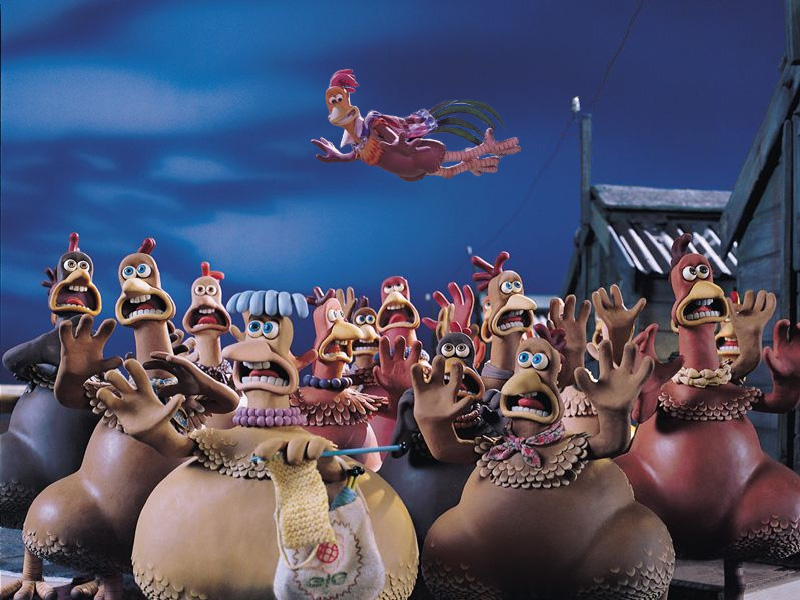 For
Wallace and Gromit fans, Chicken Run is the next phase, and even
audiences who haven't quite discovered these Oscar-winning shorts, then
Chicken
Run may well be their perfect induction into the comic world of Peter
Lord and Nick Park, who have remained true to themselves and their artistry,
despite the new Hollywood connection. "In terms of humour, you've got to
know what YOU find funny and what YOU would have happen in the story, and
not make the film for an audience out THERE. If you remain true to yourself,
then everyone else will find it true", says Park. If Chicken Run
is half as good as these guys' consistent enthusiasm and passion, then
they've got a hit on their hands. “When we started, if I could
have seen this as the final punchline, I would have been really happy,”
reflects Lord. “Is it exactly what we envisioned back then, I can’t remember.
Is it great? I think it is”, he adds laughingly.
For
Wallace and Gromit fans, Chicken Run is the next phase, and even
audiences who haven't quite discovered these Oscar-winning shorts, then
Chicken
Run may well be their perfect induction into the comic world of Peter
Lord and Nick Park, who have remained true to themselves and their artistry,
despite the new Hollywood connection. "In terms of humour, you've got to
know what YOU find funny and what YOU would have happen in the story, and
not make the film for an audience out THERE. If you remain true to yourself,
then everyone else will find it true", says Park. If Chicken Run
is half as good as these guys' consistent enthusiasm and passion, then
they've got a hit on their hands. “When we started, if I could
have seen this as the final punchline, I would have been really happy,”
reflects Lord. “Is it exactly what we envisioned back then, I can’t remember.
Is it great? I think it is”, he adds laughingly.
Chicken Run is the first full-length feature film from Aardman
Studios, and is part of a four-picture deal with DreamWorks. Co-directors
Nick Park and Peter LordWork begun working on the second feature, a reworking
of Aesop's Tortoise and the Hare, even before Chicken Run
was completed! The third feature will be the very first Wallace and
Gromit feature film. Nick Park added in early 2000: "I've been working
with Bob Baker, who wrote the last two Wallace and Gromit shorts. We don't
really get time at the moment, but we meet in the pub every two or three
months and get our ideas together. We've got quite a good, substantial
idea that's quietly simmering away, but I can't really talk about it at
the moment."
|
||||||||||||